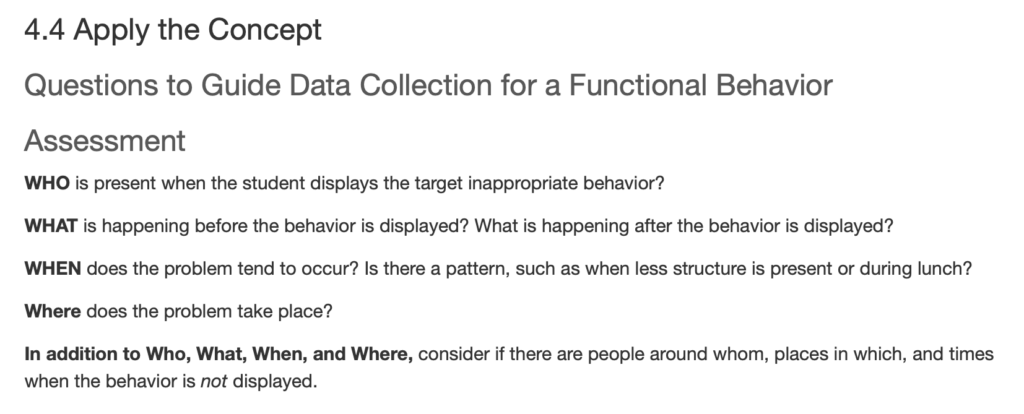For this week’s Inclusive Education topic, I wanted to touch on two important components of assessment in this realm: Functional Behaviour Assessments (FBAs) and Systematic Observations of Behaviour (SOBs). From my undergrad in Child and Youth Care, I have a pretty good handle on more “informal” social-emotional assessments, for lack of a better term. I feel pretty confident in my ability to sit down with a family and identify any challenges or underlying issues they might face. However, in Inclusive Education, the stakes are often much different than in non-profits or other social service agencies. There is much more bureaucracy involved and so many more regulations to follow, as well as a greater need for precision. As such, I thought it would be a good idea to introduce myself to some key assessment practices in the field.
Functional Behaviour Assessments (FBA)
A FBA is a tool used to gather information about student behaviours. FBAs often track three different areas: Antecedents, behaviours, and consequences. An observer conducting an FBA will also generally take note of the intensity, severity, and frequency of a behaviour. Generally a member of a student’s school-based team will keep track of what behaviours they are witnessing, in what contexts they see the behaviours, and how the behaviour is handled after the fact. They also consider external factors that may motivate behaviours, such as lack of sleep.
A FBA is commenced when a student’s school-based team — generally consisting of a teacher, administrator, Inclusive Education teacher, and perhaps other school supports like an EA, SLP, or OT — decides that a behaviour is harming a student enough to warrant intervention. An observer, who would be determined by this team, then completes an FBA through systematic observations of behaviour (more below). The goal of a FBA is to develop a support plan for a student that reduces harmful behaviours. These support plans are sometimes called Positive Behaviour Support Plans (maybe a post for another day?) Generally, negative incentives are discouraged when creating support plans through a FBA.

Systematic Observations of Behaviour (SOB)
SOBs are, essentially, structured observations of student behaviours. They can be used when note-taking for a FBA, but can also be used in different context. However, challenges with SOBs can occur when an observer is biased or when inferences and assumptions start appearing in their case notes. When an observer is making SOBs, they can “code” their notes in more or less detailed ways. For example, an observer might note a behaviour with “+” denoting an on-task behaviour and “o” standing for “off-task”. They can also use more specific codes such as “M” for motor off-task (off-task while moving around) or even more detailed with “OOS”, for instance (meaning “out of seat”). How an observer chooses to track behaviour is ultimately up to them, but the most important consideration is that they are being tracked as plainly and bias-free as possible. An observer, for example, would want to avoid statement such as “Ashleigh was causing a ruckus today” — this statement is subjective, and could mean different things to different people. Instead, they would not to note, “Ashleigh spoke four times while the teacher was talking”. Ultimately, the more objective, the better when tracking SOBs.
Below are some examples of what an FBA looks like. I am curious if anyone has seen tools like this before, and if so, what their experience have been with them!